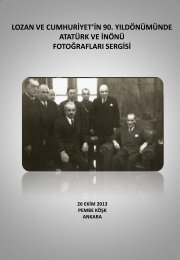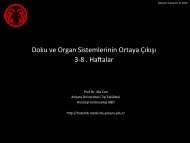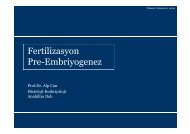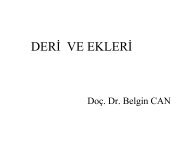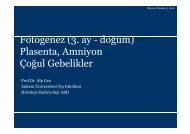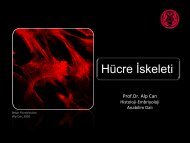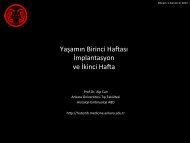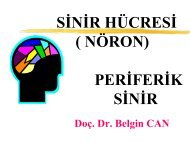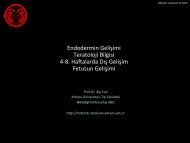dosya indir - ankaratiphastaneleri
dosya indir - ankaratiphastaneleri
dosya indir - ankaratiphastaneleri
Create successful ePaper yourself
Turn your PDF publications into a flip-book with our unique Google optimized e-Paper software.
Avrupa Resüsitasyon Konseyi 2005 Resüsitasyon K›lavuzu<br />
S77<br />
confusion over ratios and percentages in drug solutions: the<br />
case for standard labelling. J R Soc Med 2004; 97:380-3.<br />
16. Perkins GD, Stephenson B, Hulme J, Monsieurs KG. Birmingham<br />
assessment of breathing study (BABS). Resuscitation<br />
2005; 64:109-13.<br />
17. Goldacre MJ, Lambert T, Evans J, Turner G. Preregistration house<br />
officers' views on whether their experience at medical school<br />
prepared them well for their jobs: national questionnaire<br />
survey. BMJ 2003; 326:1011-2.<br />
18. Thwaites BC, Shankar S, Niblett D, Saunders J. Can consultants<br />
resuscitate? J R Coll Physicians Lond 1992; 26:265-7.<br />
19. Saravanan P, Soar J. A survey of resuscitation training needs of<br />
senior anaesthetists. Resuscitation 2005; 64:93-6.<br />
20. Featherstone P, Smith GB, Linnell M, Easton S, Osgood VM.<br />
Impact of a one-day inter-professional course (ALERT_) on attitudes<br />
and confidence in managing critically ill adult patients.<br />
Resuscitation 2005; 65:329-36.<br />
21. Harrison GA, Jacques TC, Kilborn G, McLaws ML. The prevalence<br />
of recordings of the signs of critical conditions and emergency<br />
responses in hospital wards--the SOCCER study. Resuscitation<br />
2005; 65:149-57.<br />
22. Buist M, Bernard S, Nguyen TV, Moore G, Anderson J. Association<br />
between clinically abnormal observations and subsequent<br />
in-hospital mortality: a prospective study. Resuscitation<br />
2004; 62:137-41.<br />
23. Goldhill DR, Worthington L, Mulcahy A, Tarling M, Sumner A.<br />
The patient-at-risk team: identifying and managing seriously ill<br />
ward patients. Anaesthesia 1999; 54:853-60.<br />
24. Hodgetts TJ, Kenward G, Vlachonikolis IG, Payne S, Castle N.<br />
The identification of risk factors for cardiac arrest and formulation<br />
of activation criteria to alert a medical emergency team.<br />
Resuscitation 2002; 54:125-31.<br />
25. Subbe CP, Davies RG, Williams E, Rutherford P, Gemmell L. Effect<br />
of introducing the Modified Early Warning score on clinical<br />
outcomes, cardio-pulmonary arrests and intensive care utilisation<br />
in acute medical admissions. Anaesthesia 2003;<br />
58:797-802.<br />
26. Lee A, Bishop G, Hillman KM, Daffurn K. The Medical Emergency<br />
Team. Anaesth Intensive Care 1995; 23:183-6.<br />
27. Cuthbertson BH. Outreach critical care--cash for no questions?<br />
Br J Anaesth 2003; 90:4-6.<br />
28. Parr M. Critical care outreach: some answers, more questions.<br />
Intensive Care Med 2004; 30:1261-2.<br />
29. Goldhill DR, McNarry AF. Physiological abnormalities in early<br />
warning scores are related to mortality in adult inpatients. Br J<br />
Anaesth 2004; 92:882-4.<br />
30. Subbe CP, Williams EM, Gemmell LW. Are medical emergency<br />
teams picking up enough patients with increased respiratory<br />
rate? Crit Care Med 2004; 32:1983-4.<br />
31. McBride J, Knight D, Piper J, Smith GB. Long-term effect of introducing<br />
an early warning score on respiratory rate charting<br />
on general wards. Resuscitation 2005; 65:41-4.<br />
32. Carberry M. Implementing the modified early warning system:<br />
our experiences. Nurs Crit Care 2002; 7:220-6.<br />
33. Sandroni C, Ferro G, Santangelo S, et al. In-hospital cardiac arrest:<br />
survival depends mainly on the effectiveness of the emergency<br />
response. Resuscitation 2004; 62:291-7.<br />
34. Soar J, McKay U. A revised role for the hospital cardiac arrest<br />
team? Resuscitation 1998; 38:145-9.<br />
35. Bellomo R, Goldsmith D, Uchino S, et al. A prospective before-and-after<br />
trial of a medical emergency team. Med J Aust<br />
2003; 179:283-7.<br />
36. Buist MD, Moore GE, Bernard SA, Waxman BP, Anderson JN,<br />
Nguyen TV. Effects of a medical emergency team on reduction<br />
of incidence of and mortality from unexpected cardiac arrests<br />
in hospital: preliminary study. BMJ 2002; 324:387-90.<br />
37. Parr MJ, Hadfield JH, Flabouris A, Bishop G, Hillman K. The Medical<br />
Emergency Team: 12 month analysis of reasons for activation,<br />
immediate outcome and not-forresuscitation orders.<br />
Resuscitation 2001; 50:39-44.<br />
38. Bellomo R, Goldsmith D, Uchino S, et al. Prospective controlled<br />
trial of effect of medical emergency team on postoperative<br />
morbidity and mortality rates. Crit Care Med 2004; 32:916-<br />
21.<br />
39. Kenward G, Castle N, Hodgetts T, Shaikh L. Evaluation of a<br />
medical emergency team one year after implementation. Resuscitation<br />
2004; 61:257-63.<br />
40. Jones D, Bates S, Warrillow S, et al. Circadian pattern of activation<br />
of the medical emergency team in a teaching hospital. Crit<br />
Care 2005; 9:R303-R6.<br />
41. The MERIT study investigators. Introduction of the medical<br />
emergency team (MET) system: a cluster-randomised controlled<br />
trial. Lancet 2005; 365:2091-7.<br />
42. Critical care outreach 2003: progress in developing services.<br />
The National Outreach Report 2003. London, Department of<br />
Health and National Health Service Modernisation Agency,<br />
2003.<br />
43. Ball C, Kirkby M, Williams S. Effect of the critical care outreach<br />
team on patient survival to discharge from hospital and readmission<br />
to critical care: non-randomised population based<br />
study. BMJ 2003; 327:1014.<br />
44. Priestley G, Watson W, Rashidian A, et al. Introducing Critical<br />
Care Outreach: a ward-randomised trial of phased introduction<br />
in a general hospital. Intensive Care Med 2004; 30:1398-<br />
404.<br />
45. Story DA, Shelton AC, Poustie SJ, Colin-Thome NJ, McNicol PL.<br />
The effect of critical care outreach on postoperative serious adverse<br />
events. Anaesthesia 2004; 59:762-6.<br />
46. Szalados JE. Critical care teams managing floor patients: the<br />
continuing evolution of hospitals into intensive care units? Crit<br />
Care Med 2004; 32:1071-2.<br />
47. Cooke MW, Higgins J, Kidd P. Use of emergency observation<br />
and assessment wards: a systematic literature review. Emerg<br />
Med J 2003; 20:138-42.<br />
48. Rivers E, Nguyen B, Havstad S, et al. Early goal-directed therapy<br />
in the treatment of severe sepsis and septic shock. N Engl<br />
J Med 2001; 345:1368-77.<br />
49. Leeson-Payne CG, Aitkenhead AR. A prospective study to assess<br />
the demand for a high dependency unit. Anaesthesia<br />
1995; 50:383-7.<br />
50. Guidelines for the utilisation of intensive care units. European<br />
Society of Intensive Care Medicine. Intensive Care Med 1994;<br />
20:163-4.<br />
51. Haupt MT, Bekes CE, Brilli RJ, et al. Guidelines on critical care<br />
services and personnel: Recommendations based on a system<br />
of categorization of three levels of care. Crit Care Med 2003;<br />
31:2677-83.<br />
52. Hillson SD, Rich EC, Dowd B, Luxenberg MG. Call nights and<br />
patients care: effects on inpatients at one teaching hospital. J<br />
Gen Intern Med 1992; 7:405-10.<br />
53. Bell CM, Redelmeier DA. Mortality among patients admitted<br />
to hospitals on weekends as compared with weekdays. N Engl<br />
J Med 2001; 345:663-8.<br />
54. Beck DH, McQuillan P, Smith GB. Waiting for the break of<br />
dawn? The effects of discharge time, discharge TISS scores and<br />
discharge facility on hospital mortality after intensive care. Intensive<br />
Care Med 2002; 28:1287-93.<br />
55. Needleman J, Buerhaus P, Mattke S, Stewart M, Zelevinsky K.<br />
Nurse-staffing levels and the quality of care in hospitals. N Engl<br />
J Med 2002; 346:1715-22.<br />
56. Baskett PJ, Lim A. The varying ethical attitudes towards resuscitation<br />
in Europe. Resuscitation 2004; 62:267-73.<br />
57. Gabbott D, Smith G, Mitchell S, et al. Cardiopulmonary resuscitation<br />
standards for clinical practice and training in the UK.<br />
Resuscitation 2005; 64:13-9.<br />
58. Bristow PJ, Hillman KM, Chey T, et al. Rates of in-hospital arrests,<br />
deaths and intensive care admissions: the effect of a medical<br />
emergency team. Med J Aust 2000; 173:236-40.<br />
59. Eberle B, Dick WF, Schneider T, Wisser G, Doetsch S, Tzanova<br />
I. Checking the carotid pulse check: diagnostic accuracy of first



